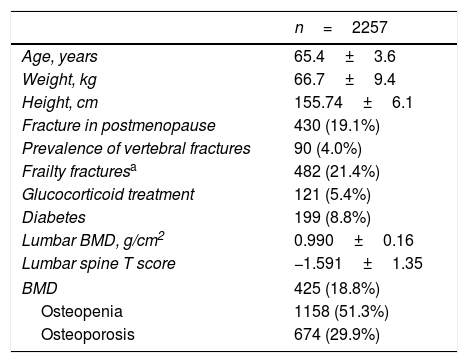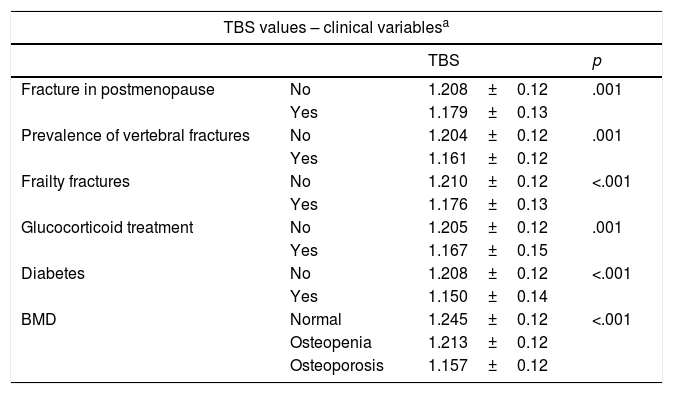The trabecular bone score (TBS) is an imaging technique that assesses the condition of the trabecular microarchitecture. Preliminary results suggest that TBS, along with the bone mineral density assessment, could improve the calculation of the osteoporotic fracture risk. The aim of this study was to analyze TBS values and their relationship with the clinical characteristics, bone mineral density and history of fractures of a cohort of posmenopausal women.
Materials and methodsWe analyzed 2257 posmenopausal women from the FRODOS cohort, which was created to determine the risk factors for osteoporotic fracture through a clinical survey and bone densitometry with vertebral morphometry. TBS was applied to the densitometry images. TBS values ≤1230 were considered indicative of degraded microarchitecture. We performed a simple and multiple linear regression to determine the factors associated with this index.
ResultsThe mean TBS value in L1–L4 was 1.203±0.121. Some 55.3% of the women showed values indicating degraded microarchitecture. In the multiple linear regression analysis, the factors associated with low TBS values were age, weight, height, spinal T-score, glucocorticoid treatment, presence of type 2 diabetes and a history of fractures due to frailty.
ConclusionsTBS showed microarchitecture degradation values in the participants of the FRODOS cohort and was associated with anthropometric factors, low bone mineral density values, the presence of fractures, a history of type 2 diabetes mellitus and the use of glucocorticoids.
El Trabecular Bone Score (TBS) es una técnica de imagen que evalúa el estado de la microarquitectura trabecular. Resultados preliminares sugieren que, junto a la valoración de la densidad mineral ósea, podría mejorar la estimación del riesgo de fractura ostoporótica. El objetivo de este estudio fue analizar los valores de TBS y su relación con las características clínicas, densidad mineral ósea y antecedentes de fracturas en una cohorte de mujeres posmenopáusicas.
Material y métodosAnalizamos 2.257 mujeres posmenopáusicas procedentes de la cohorte FRODOS, constituida para determinar los factores de riesgo de fractura osteoporótica mediante una encuesta clínica y densitometría ósea con morfometría vertebral. Se aplicó el TBS a las imágenes densitométricas. Valores de TBS ≤1,230 se consideraron indicativos de microarquitectura degradada. Se realizó una regresión lineal simple y múltiple para determinar los factores asociados con este índice.
ResultadosEl valor medio de TBS en L1-L4 fue de 1,203±0,121. El 55,3% de las mujeres presentaban valores de microarquitectura degradada. En el análisis de regresión lineal múltiple los factores asociados a los valores bajos de TBS fueron la edad, el peso, la altura, escala T de columna lumbar, tratamiento con glucocorticoides, presencia de diabetes tipo 2 y antecedentes de fractura por fragilidad.
ConclusionesEl TBS mostró valores de microarquitectura degradada en las participantes de la cohorte FRODOS y se asoció a factores antropométricos, valor bajo de densidad mineral ósea, presencia de fracturas, antecedentes de diabetes mellitus tipo 2 y uso de glucocorticoides.
Article
Diríjase desde aquí a la web de la >>>FESEMI<<< e inicie sesión mediante el formulario que se encuentra en la barra superior, pulsando sobre el candado.

Una vez autentificado, en la misma web de FESEMI, en el menú superior, elija la opción deseada.

>>>FESEMI<<<










